TranscendPang might be the best Pang-style game out there, freeware or otherwise. This psychedelic take on the arcade classic still has you shooting wires upward to split bouncing circles into smaller bouncing circles, but it adds in a whole slew of new things. With branching paths, bizarre bosses and minibosses, a clever bomb mechanic, and tons of playable characters, each with a unique ability and varying stats, TranscendPang takes the original formula to the next stage.
If you’re unfamiliar with this particular arcade subgenre, the basic gameplay is pretty straightforward. Each stage takes place within a single, square room. Large balls gradually drop in from the ceiling and bounce around in the playing field while your own character is purely limited to moving left and right on the floor. You attack by shooting wires upward to repeatedly split the balls into two smaller ones until they’re eventually destroyed. You can only have two wires on-screen at once and you can’t make more until one of them disappears due to either hitting the ceiling or from making contact with a ball, but even hits from the side count. In general, larger balls are more dangerous because they bounce quickly and cover a lot of ground, but smaller ones are still a threat because they remain closer to the stage of your own character and can quickly become overwhelming.
There are quite a few ways in which TranscendPang changes things up, though the one design choice which everything else relies upon is its approach to stage progression. Rather than taking place over the course of dozens of stages filled with varying ladder, platform, and enemy layouts, TranscendPang takes place over seven (or six depending on the game mode) stages which are all completely empty squares. On top of this, balls will fall in from the sky indefinitely rather than starting with a predetermined layout and each stage is divided into somewhere around four or five waves. So, if there’s no limit to the number of enemies and every stage is just an empty box, where does progression and, more important, variety come from? To answer the first half of this question, you progress via getting points.
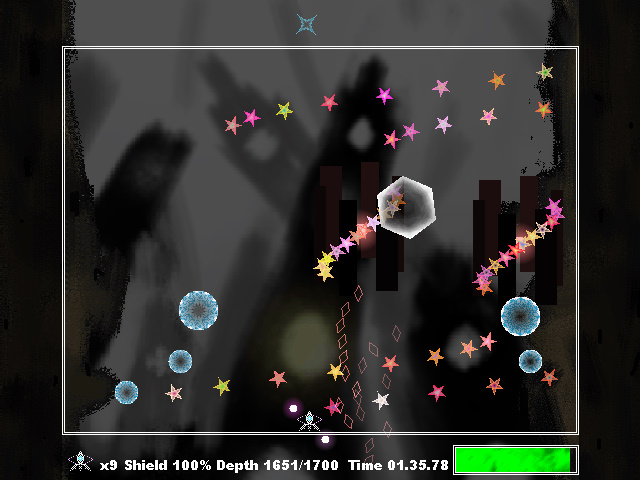
The scoring system is a vital component to TranscendPang. Represented as ‘depth’, the points you earn allow you to progress through the stage after hitting various milestones. You earn points just from splitting and destroying balls, but you also wrack up bonuses for performing feats like getting bombs to certain sizes (more on those later) or consecutively hitting balls of the same size. Once you get enough points to hit the milestone indicated by the final wave, the remaining balls will soon disappear and the boss fight for the stage will begin. You can also hold down left shift (or some other button since the controls can be completely customized) to make balls spawn in faster, allowing you to potentially earn points much more quickly with greater risk. The speed at which you earn points doesn’t matter much in Advanced Mode, where everything is set in stone, but it’s a crucial element in Wander Mode, which is the main mode of the game.
Wander Mode is divided into seven stages, but just which seven stages you play through depends upon your skill. Each stage in this mode has a ‘norma’ time which determines the stage you go to afterwards. Reaching the maximum depth in a stage within the norma time will let you fight a much harder, ‘NEO’ version of the boss and, upon winning that fight, take the upper branch in the path split. For example, failing to hit the norma in the first stage will send you to Stage 2-A, Easy-O, while achieving the norma will let you ascend to 2-B, LoveEntropy, and from there either 3-C or 3-B. Some of the stages in the middle of the map have three-way splits which depend on if you achieve the norma and your remaining lives, but in general the choice is between C and B or between B and A. These time limits are also rather strict so, while you don’t need to hold down left shift for the entire stage, you do need to spend a good chunk of a stage with the faster spawn rate on and/or become really good at getting point combos to hit these requirements (for the record, I’ve only ever been able to finish the A path and have seen about half of B and almost nothing of C). The branching paths of Wander Mode give the game a ton of replay value and each path’s difficulty is scaled appropriately.
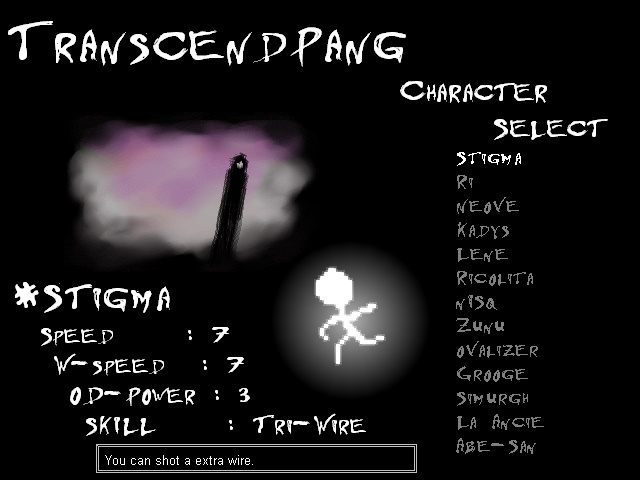
Now, what about the matter of variety? Well, there’s actually quite a bit of it, starting with the characters and difficulty levels. The two difficulties to choose between are Normal and Abnormal (Hard) Mode and they affect the way your health and ‘overdrive’ work. In Normal Mode you have a shield which starts at 100% and goes down by 50% each time you get hit, but it gradually recharges in addition to certain bonuses recharging a large chunk of it. You also have a green gauge in this mode which fills as you damage non-boss enemies and when it’s full you can either use it up to activate your character’s special skill for a few seconds or to use your overdrive, which clears the screen of normal enemies and injures bosses. In Abnormal Mode, you still have the green gauge, but it’s used exclusively for the special skill. You also die in one hit from anything because you don’t have a shield in this mode, but each of your lives comes with a fresh supply of multiple overdrive uses and there are ways to obtain more of them, like bombs in a shmup.
There is an impressive total of 13 characters to choose from (plus at least one hidden character) and they actually do play fairly differently from one another despite sharing the same basic mechanics. To begin with, each character has different stats for their own movement speed, the wire’s speed, and how much damage their overdrive does to bosses. These differences may seem trivial, but they can end up saving (or costing) you a life, especially during the more chaotic boss fights. Even though stats are important, skills are the main deciding factor when it comes to selecting your character.
Some skills are more defensive in nature, such as granting you a one-hit shield or temporarily cutting the speed of balls in half. These skills are great if you’re taking on the easier stages or playing through Advanced Mode where time doesn’t matter. On the other hand, offensive skills like Zunu’s added explosions on your wire can really help during tough boss fights or when trying to hit the norma and you can have a good chunk of the gauge refilled by the time they wear off. Last of all, you can actually set the abilities of up to two other characters as ‘sub-skills’ which are used by pressing down or up upon skill activation, though these skills drain the bar at a much faster rate than a character’s personal skill. Sub-skills are pretty great to have, but what isn’t so great is the fact that the game never tells you about them and the online manual only hints at their existence; I had to stumble upon them by accidentally pressing left and right on the character select screen.
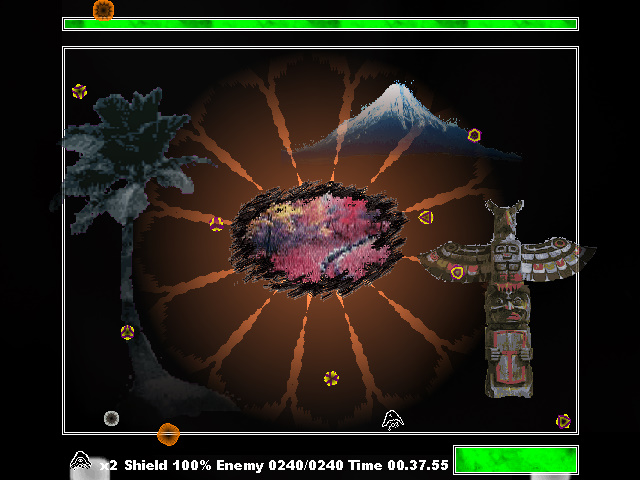
Music is the main source of variety for the stages themselves. Not only is the soundtrack exceptionally good, each stage features a song by a different artist, it factors directly into the gameplay. The tempo of each song affects the speed enemies move at so slower songs tend to feature more lethargic enemies which attack from odd angles while fast songs can make even the standard enemies rather dangerous. TranscendPang goes the extra mile in this regard because movement speeds adjust based on the current speed of the song at any given time rather than being based on a flat rate for the entire song. Songs gradually change as you reach new waves within the stage, adding in more complexity or adjusting the rhythm to in turn adjust the flow of the gameplay. Stage 5-A, Growing Train, makes for an especially great example because, in addition to having a cool monochrome aesthetic with train tracks scrolling by in the background, the tempo constantly slows down and speeds up as the train stops at and departs from stations.
The music’s beat is possibly even important than the tempo. Stages only transition between waves at the start of a musical measure, including the final transition to the boss fight, so you might remain within a wave for a few seconds even after hitting the current score requirement. Every boss also has at least two, often three, phases which it will only transition between at these intervals, forcing you to stave off attacks from the boss and enemies even if the current phase has zero health. However, the beat is primarily crucial because of how it affects bombs.
The bomb system is one of the best innovations introduced by TranscendPang. There are a few different types of bombs, but the most common ones are the ones which you create. There are five ball sizes and landing enough hits on the largest type of ball to split at least part of it all the way down into the smallest type before it touches the ground will usually result in the smallest pieces becoming bombs. Bombs bounce around like normal balls, they can’t be destroyed, and they can still hurt you if they make contact, but they will ignite and then explode at the start of a measure. You actually have a fair amount of control over when and where these bombs explode because you can use the wire to position them and each time they are hit their timer resets to a neutral state.
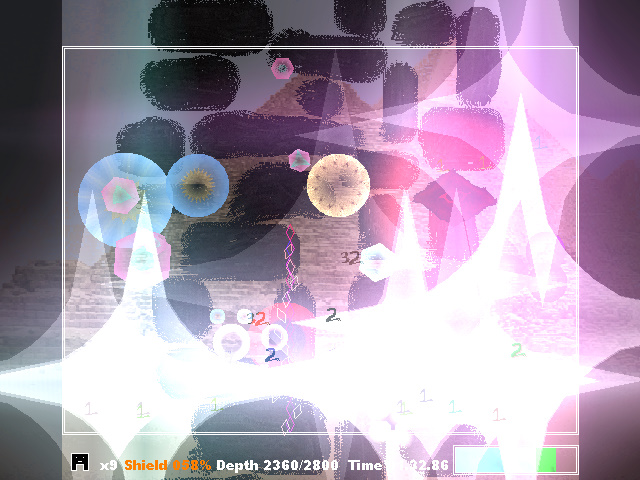
When a bomb explodes, any balls in the explosion one size larger than the bomb will be transformed into bombs and any of a smaller size will be destroyed. Bombs allow you to set up massive chain reactions and you get various bonuses based on the size of the final bomb in the chain. You can also use your wire to shove bombs into bosses and minibosses to make them instantly explode for massive burst damage; bombs are created one size up from the minimum during boss fights to make it easier to get these burst attacks in. Balls can also sometimes simply start out as bombs of varying sizes and, in certain stages, alternate bombs may also appear, such as ones which don’t have their explosions tied to the music.
Enemies are surprisingly varied for this type of game. Each stage has a unique type of miniboss called a sentinel which periodically appears about halfway up the play area alone or in groups of two or three. Sentinels only take a few hits to destroy, but hitting them isn’t always easy as they fire plenty of bullets (which you may or may not be able to destroy) and some of them are quite mobile. While the standard balls are the primary enemies in every stage, there are a few other normal enemy types which can appear as well. For example, in some stages there are medium-sized enemies which instantly disperse into about half a dozen small enemies when hit and at other times there are diamond-shaped enemies which slowly glide through the air instead of bouncing and you may need to launch a wire and then run away if one glides down to the floor.
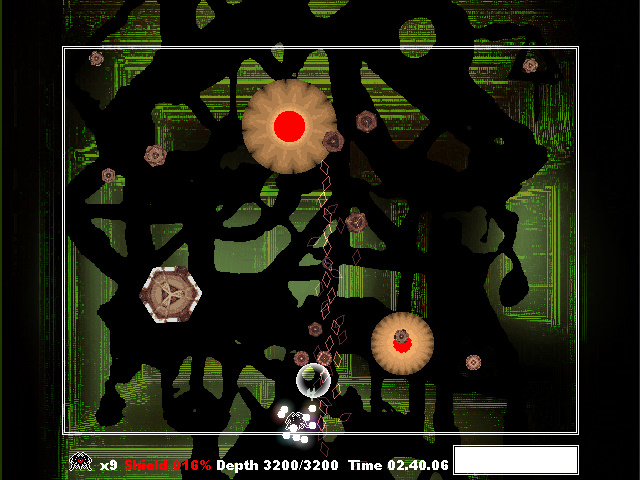
Normal enemies and sentinels can be dangerous, but bosses are where the challenge really kicks in. There’s a boss in every stage and with a grand total of 19 stages that means this game has quite a few bosses, each with at least two phases and two significantly different versions of those phases based on if you hit the norma time. Most bosses are weird, abstract things like a giant clock or a photo which changes to reflect different seasons and in turn changes its attacks. Enemies still gradually pour in during these fights, which makes the already dangerous attacks even more difficult to dodge while also providing you with an endless supply of potential bombs. Your gauge doesn’t fill up from hitting bosses and sentinels either, so the enemy supply definitely helps at least as much as it hurts.
There’s a good chance that most of your deaths will come from these bosses, especially if you’re going up against their NEO versions. The first boss makes for a great example of the differences between phases and versions. Normally, this boss, which is a square, moss-like floating face, periodically sends out ‘tears’ from its eyes which disappear when they touch the ground in the first phase and it spends the second phase trying to crush you by slamming into the ground. In the NEO version of the fight, the tears are normal balls which remain in play until you destroy them and every time it slams the ground it creates shockwaves which you need to get rid of by hitting them with the side of your wire. Boss fights are some of the best parts of TranscendPang and you can even refight these bosses after defeating them whenever you want in Invasion Mode, which also lets you practice individual stages.
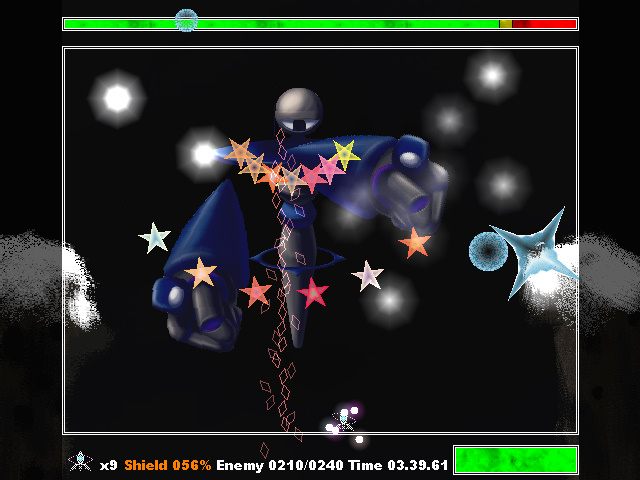
As odd as it is to say, the one area in which TranscendPang falls short is in its aesthetics. On the positive side of things you have the music, which directly affects the gameplay and consists of a very solid soundtrack. The sound effects are also incredible because they transform every song into a true soundscape; the noises of firing your wire and hitting the various enemy types are all cymbal hits, drum beats, guitar riffs, and other types of musical notes which completely change based on the stage. The issues appear when it comes to the graphics. The art in TranscendPang isn’t stellar, but it makes up for that by using its abstract aesthetic to its advantage to create a surreal world filled with deliberately clashing styles and even photos.
Unfortunately, the background art has a habit of getting in the way of the action. This game has a love of flashing effects which look cool and give the game a rave-like atmosphere to go along with the strong musical focus, but they can also make it incredibly hard to tell what’s going on. If you’re familiar with Beat Hazard, imagine playing that with the effects set to somewhere near the maximum with no way to turn them down for the harder stages. Other than the flashing effects, the scrolling backgrounds are sometimes overly busy or overly colorful to the point that it can become incredibly difficult to differentiate them from the enemies and bullets. Neither of these things are constant issues, but they do crop up often enough that every now and then I would take damage from something I didn’t even notice.
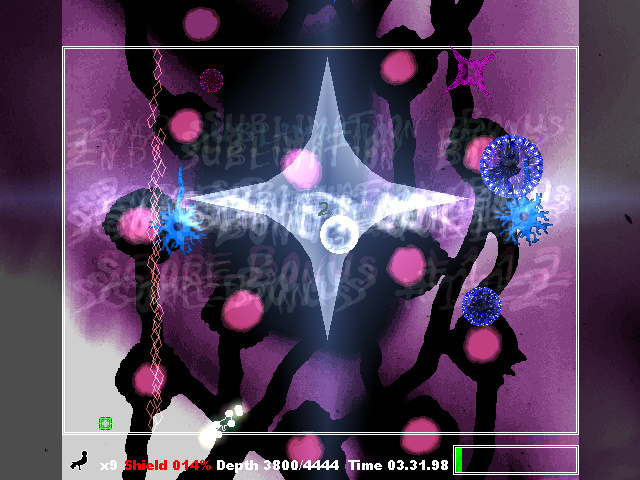
TranscendPang definitely lives up to its name. It doesn’t completely change around basic component of the original formula like The Bug Butcher does and, instead, it adds entirely new mechanics on top of the existing foundation to ascend to a level beyond that achieved by the original.